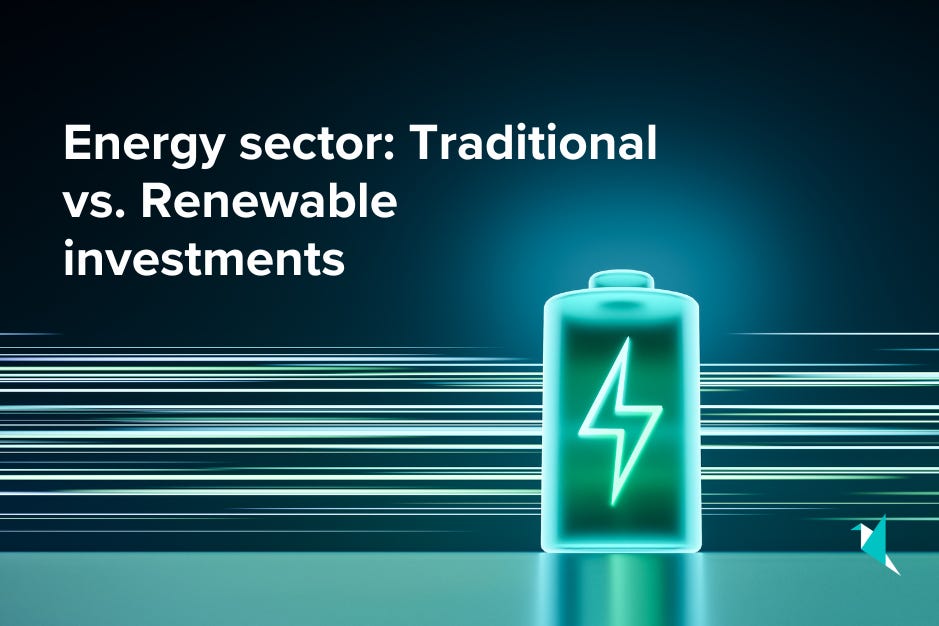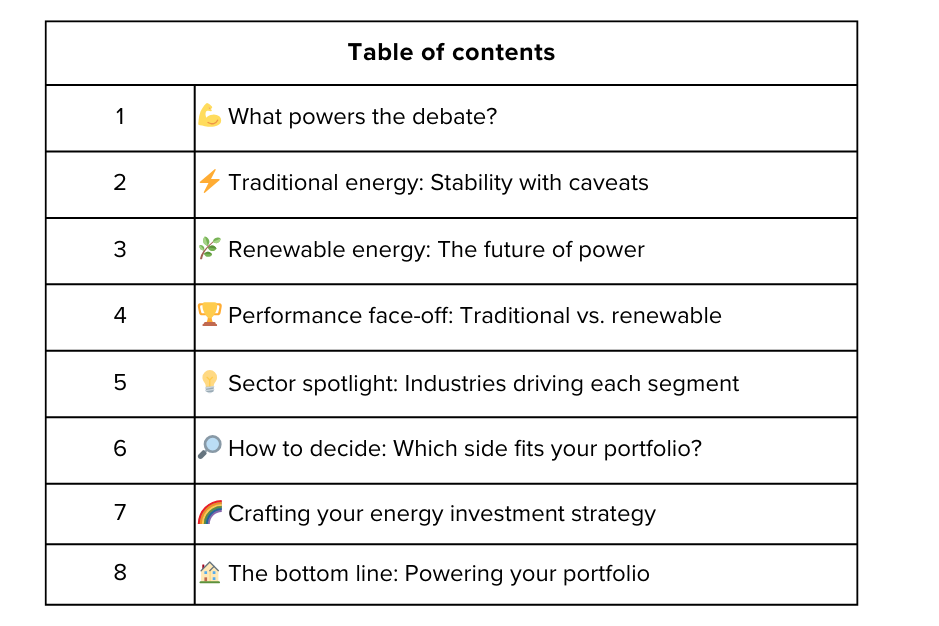Energy sector: Traditional vs. Renewable investments
Have you ever felt torn between old ways and new ideas? The energy sector faces a similar choice. Investors must decide between the dependable stability of traditional energy and the exciting possibilities of renewable energy. This decision doesn’t just shape portfolios—it affects industries and even the planet. Let’s explore these two options to see which might suit your goals and values.
What powers the debate? 💪
Energy keeps our world running, but not all energy sources are the same. Traditional energy comes from fossil fuels like oil, coal, and natural gas. These have powered economies for years. Renewable energy, on the other hand, uses natural resources like sunlight, wind, and water—sources that don’t run out and are cleaner for the environment.
Choosing between these depends on factors like risk, returns, and long-term benefits. Let’s break it down.
Traditional energy: Stability with caveats ⚡
Traditional energy companies are industry giants. They have massive infrastructure, employ millions, and are vital to the global economy. However, they come with some downsides.
Pros of traditional energy investments
Proven systems: Traditional energy has decades of investment in production and transport, like a reliable old car that still works well.
Steady earnings: These companies often have consistent revenue, which is great for investors who want regular income.
Dividends: Big names like ExxonMobil and BP pay regular dividends, offering a stable income stream.
Global need: Despite the rise of renewables, fossil fuels still make up a large part of global energy use.
An offshore oil rig, showing the scale of traditional energy.
Cons of traditional energy investments
Environmental impact: Fossil fuels cause pollution and greenhouse gases, leading to ethical and regulatory concerns.
Price swings: Oil and gas prices can change quickly due to global events or decisions by organizations like OPEC.
Limited future growth: As more people and governments push for cleaner energy, demand for fossil fuels may drop over time.
Renewable energy: The future of power 🌿
Renewables are growing quickly. Companies in this space are attracting investments and creating new technologies. Renewable energy offers big opportunities for both the environment and investors.
Pros of renewable energy investments
Growth opportunities: With global goals for net-zero emissions, renewable energy is expected to grow rapidly. Solar and wind energy are leading this charge.
Sustainability: Renewable energy uses sources like sunlight and wind, which don’t run out, making it a safer long-term option.
Government help: Many countries offer subsidies and tax benefits to renewable energy companies, helping them expand.
Innovation: New technologies like better battery storage are making renewable energy more efficient and cheaper.
A wind farm showcasing renewable energy’s potential.
Cons of renewable energy investments
High upfront costs: Building solar panels or wind farms requires a lot of money initially.
Unpredictable supply: Sunlight and wind aren’t always available, making energy production less consistent.
Tough competition: Many companies are entering this growing market, which can lower profits.
Policy changes: Governments can change their support for renewables, affecting company growth.
Performance face-off: Traditional vs. renewable 🏆
What would happen if you invested $1,000 in each type of energy in 2013? Let’s compare.
Traditional energy
A $1,000 investment in a traditional energy index could now be worth about $1,800. This includes regular dividends but reflects slower growth due to challenges like shifting away from fossil fuels. Traditional energy is predictable, making it attractive for those who want steady income.
Renewable energy
The same $1,000 in a renewable energy fund might now be worth $2,400. The growth is impressive, but the ride would have been bumpier, with big price swings due to new technologies and changing policies. It’s riskier but offers higher potential rewards.
This shows the trade-off: traditional energy is steady but slower, while renewables grow faster but are more unpredictable.
Sector spotlight: Industries driving each segment 💡
Oil and gas (Traditional energy)
Companies like Chevron and Shell dominate this space, providing resources for industries and households.
Challenges include meeting new environmental rules and costs for carbon offsets.
Solar and wind (Renewable energy)
Companies like NextEra Energy and Vestas lead the way, building massive solar and wind projects.
Falling costs for solar panels have driven growth and profits.
Hybrid players
Some companies, like TotalEnergies, invest in both traditional and renewable energy, balancing stability and growth.
How to decide: Which side fits your portfolio? 🔎
Choosing between traditional and renewable energy depends on your personal goals, financial needs, and risk tolerance. Here’s a deeper look at how to decide:
Key questions to ask yourself:
What are your investment goals?
Are you looking for steady income, or do you want high-growth potential? Traditional energy provides more stability, while renewables offer greater long-term growth.
How much risk can you handle?
Traditional energy is less volatile, making it ideal for cautious investors. Renewables, however, come with higher risks and rewards.
What’s your time horizon?
If you need returns in the short term, traditional energy might be better. For long-term goals, renewables can be a strong choice.
Do your values align with your investments?
Investing in renewables supports sustainability and clean energy, which might match your ethical or environmental beliefs.
When to choose traditional energy
You want stable, regular income through dividends. Traditional energy companies often pay consistent dividends, making them reliable for income-focused portfolios.
You prefer established companies with predictable earnings. Fossil fuel companies have decades of track records, offering confidence in their stability.
You need safer investments for short-term goals. If you’re planning to use your returns in a few years, traditional energy’s low volatility is appealing.
When to choose renewable energy
You’re seeking high growth and are okay with market ups and downs. Renewable energy companies are growing quickly, and their stocks often reflect this.
You care about sustainability and want to invest in a cleaner future. If aligning your investments with your values is important, renewables are the clear choice.
You have a long-term horizon. As renewable energy expands and technology improves, the sector’s value is likely to grow over time.
Blending the two
Many investors find success by combining traditional and renewable energy investments. This approach allows you to benefit from the stability of traditional energy while capturing the growth potential of renewables. It also creates a diversified portfolio that can adapt to changing market conditions.
Crafting your energy investment strategy 🌈
Mix it up: Invest in both traditional and renewable energy to balance stability and growth.
Stay informed: Follow energy trends and policies to adjust your investments as needed.
Know your risk: Decide how much risk you can handle and choose accordingly.
Look ahead: Energy changes will take decades, so plan for the long term.
Check often: Review your portfolio regularly to keep it aligned with your goals.
Consider hybrids: Companies in both sectors can offer a mix of stability and innovation.
A diversified portfolio can help reduce risks and capture opportunities.
The bottom line: Powering your portfolio 🏠
Both traditional and renewable energy have strengths and challenges. Traditional energy offers stability, while renewables promise growth and sustainability. You don’t have to pick just one. A balanced approach can help you meet your financial goals.
As the energy world evolves, you can invest in shaping the future while earning returns. Whether you prefer the reliability of oil rigs or the promise of wind turbines, there’s room for both in your portfolio. Energy powers the world—and your success.
Disclaimer: All content provided by Winvesta India Technologies Ltd. is for informational and educational purposes only and is not meant to represent trade or investment recommendations. Remember, your capital is at risk. Terms & Conditions apply.







